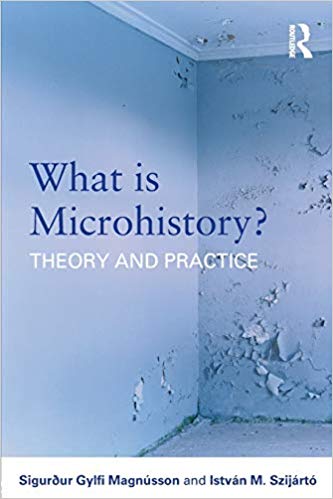 What is Microhistory? Theory and Practice. Co-author Dr. István M. Szijártó (London: Routledge, 2013). 181 pages.
What is Microhistory? Theory and Practice. Co-author Dr. István M. Szijártó (London: Routledge, 2013). 181 pages.
Routledge published a book by Sigurdur Gylfi Magnússon and István M. Szijártó, in which they dealt with the same question, but from very different points of view. This emerged clearly in the book; indeed their differences are an integral part of the book’s structure. The first part of the book István Szijártó addresses what he sees as the principal characteristics of microhistory, focusing mainly on the factor he terms a “great historical question.” István Szijártó brings out three factors which he sees as typifying microhistory, and searches for them in his discussion of the many works he chooses to address in our book. The common factors of these writings is that they are either deemed to belong to the microhistorical genre, and are studies that he thinks deserves to be considered part of it, or those he judges not to meet the criteria. The factors which, in Szijártó’s judgment, determine whether a study may be categorized as a good microhistorical work, are the following: a) the reduction of the scale of observation, b) “a great historical question”, c) agency.
These factors are, of course based upon certain fundamental principles upheld by the vast majority of microhistorians, which may be briefly defined as an “analysis, at extremely close range, of highly circumscribed phenomena – a village community, a group of families, even an individual person,” as Ginzburg and Poni put it in their important study.
At the beginning of the final chapter of What is Microhistory? Sigurður Gylfi enumerate ten factors which may be applied to answering the above question – posed in the book heading. These are factors: “… which are generally recognized as being indispensible on the agenda of this type of history … (1) the role of narrative; (2) synthesis in history; (3) history and fiction; (4) historical subjectivity; (5) normal exceptions; (6) the reduction of the scale of observation; (7) the individual and the past; (8) ethnological and anthropological methodology; (9) microhistory and relativism; (10) contextualization”.
For each specific study which may be classified as microhistory, each one of these idems is not necessarily of equal importance; but we may say that all the factors are considered, in one form or another, by historians who are classified as microhistorians. They will reach some conclusion about similar phenomena at some point in the research process: it would be almost unavoidable to do anything else. This fact makes microhistory into the scholarly force that Sigurður Gylfi believe it is. The method requires the researcher to place is/her work in a specific scholarly context, the form of which is variable according to the circumstances.
See also an introduction by Routledge:
This unique and detailed analysis provides the first accessible and comprehensive introduction to the origins, development, methodology of microhistory – one of the most significant innovations in historical scholarship to have emerged in the last few decades.
The introduction guides the reader through the best-known example of microstoria, The Cheese and the Worms by Carlo Ginzburg, and explains the benefits of studying an event, place or person in microscopic detail. In Part I, István M. Szijártó examines the historiography of microhistory in the Italian, French, Germanic and the Anglo-Saxon traditions, shedding light on the roots of microhistory and asking where it is headed. In Part II, Sigurður Gylfi Magnússon uses a carefully selected case study to show the important difference between the disciplines of macro- and microhistory and to offer practical instructions for those historians wishing to undertake micro-level analysis. These parts are tied together by a Postscript in which the status of microhistory within contemporary historiography is examined and its possibilities for the future evaluated.
What is Microhistory? surveys the significant characteristics shared by large groups of microhistorians, and how these have now established an acknowledged place within any general discussion of the theory and methodology of history as an academic discipline.
